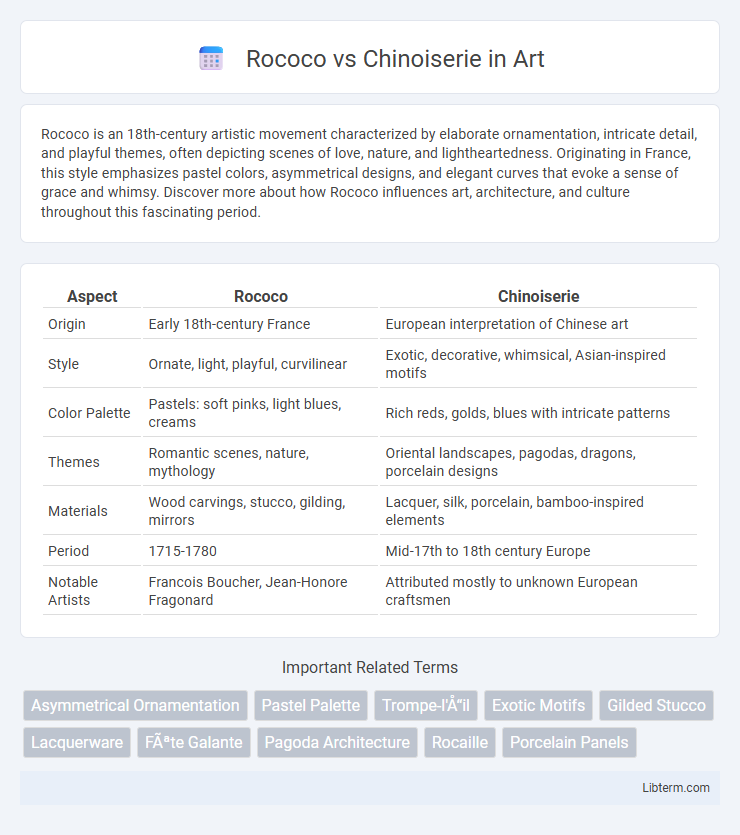Rococo is an 18th-century artistic movement characterized by elaborate ornamentation, intricate detail, and playful themes, often depicting scenes of love, nature, and lightheartedness. Originating in France, this style emphasizes pastel colors, asymmetrical designs, and elegant curves that evoke a sense of grace and whimsy. Discover more about how Rococo influences art, architecture, and culture throughout this fascinating period.
Table of Comparison
| Aspect | Rococo | Chinoiserie |
|---|---|---|
| Origin | Early 18th-century France | European interpretation of Chinese art |
| Style | Ornate, light, playful, curvilinear | Exotic, decorative, whimsical, Asian-inspired motifs |
| Color Palette | Pastels: soft pinks, light blues, creams | Rich reds, golds, blues with intricate patterns |
| Themes | Romantic scenes, nature, mythology | Oriental landscapes, pagodas, dragons, porcelain designs |
| Materials | Wood carvings, stucco, gilding, mirrors | Lacquer, silk, porcelain, bamboo-inspired elements |
| Period | 1715-1780 | Mid-17th to 18th century Europe |
| Notable Artists | Francois Boucher, Jean-Honore Fragonard | Attributed mostly to unknown European craftsmen |
Introduction to Rococo and Chinoiserie
Rococo is an 18th-century artistic movement characterized by elaborate ornamentation, asymmetrical designs, pastel colors, and themes of love and nature, originating in France as a reaction to the grandeur of Baroque art. Chinoiserie represents European interpretations and imitations of Chinese and East Asian artistic traditions, featuring motifs such as pagodas, dragons, and intricate floral patterns, popular during the 17th and 18th centuries. Both styles reflect cultural exchanges, with Rococo emphasizing playful elegance and Chinoiserie showcasing exoticism and fascination with Asian aesthetics.
Historical Origins and Development
Rococo originated in early 18th-century France as an elaborate artistic movement characterized by ornate decoration, intricate patterns, and playful themes reflecting the aristocratic lifestyle. In contrast, Chinoiserie emerged during the same period in Europe as a fascination with East Asian art and culture, incorporating exotic motifs such as pagodas, dragons, and intricate lacquer work into Western design. Both styles evolved through cross-cultural exchanges and shifting tastes, with Rococo emphasizing Rocaille ornamentation and Chinoiserie representing Western interpretations of Chinese aesthetics.
Key Aesthetic Principles
Rococo emphasizes ornate curves, intricate floral motifs, and asymmetry that create a light, playful elegance rooted in 18th-century French aristocratic taste. Chinoiserie integrates exotic East Asian influences with stylized nature scenes, pagodas, and lacquered surfaces, reflecting Western fascination with Oriental art during the same period. Both styles use elaborate decoration but Rococo favors fluidity and pastels, while Chinoiserie highlights bold contrasts and cultural symbolism.
Iconic Motifs and Decorative Elements
Rococo features intricate scrollwork, shell motifs, and floral patterns characterized by asymmetry and elaborate curves, emphasizing lightness and elegance in decorative arts. Chinoiserie incorporates stylized Chinese motifs such as pagodas, dragons, exotic birds, and oriental landscapes, reflecting Western interpretations of East Asian aesthetics with a focus on exoticism and fantasy. Both styles utilize lavish ornamentation but differ in thematic sources: Rococo grounded in European naturalism and Chinoiserie inspired by East Asian culture and exotic decorative elements.
Color Palettes and Materials
Rococo color palettes emphasize pastel hues such as soft pinks, pale blues, and creamy whites, often combined with gilded accents and intricate gold leaf detailing to enhance its opulent and airy feel. Chinoiserie features bolder color schemes with rich reds, deep blues, jade greens, and lacquered finishes inspired by traditional Chinese art and porcelain, creating a vibrant and exotic atmosphere. Materials in Rococo interiors typically include carved wood, silk, and porcelain, while Chinoiserie incorporates lacquered wood, bamboo, and hand-painted wallpapers or ceramics to evoke an Asian-inspired aesthetic.
Influences from Eastern and Western Cultures
Rococo art and design exhibit strong Western influences characterized by intricate ornamentation, asymmetry, and light pastel colors inspired by the French aristocracy. Chinoiserie reflects Eastern influences through its interpretation of Chinese motifs, such as pagodas, dragons, and exotic flora, adapted by European artists to evoke a romanticized vision of the Far East. Both styles merge cultural elements, with Rococo emphasizing European elegance and Chinoiserie showcasing a fascination with Asian decoration and storytelling.
Differences in Architecture and Interior Design
Rococo architecture and interior design emphasize intricate ornamentation with asymmetrical patterns, pastel color palettes, and motifs inspired by nature such as shells and flowers, reflecting 18th-century European elegance. Chinoiserie incorporates Chinese artistic influences with bold patterns, lacquer finishes, and motifs like pagodas, dragons, and exotic flora, creating an exotic and whimsical aesthetic within Western architectural and interior frameworks. The Rococo style favors lightness and playful curves, while Chinoiserie integrates Eastern symbolism and decorative techniques, resulting in distinctly different spatial experiences.
Major Artists and Designers
Rococo's major artists include Jean-Honore Fragonard and Francois Boucher, known for their intricate, playful, and ornamental works emphasizing lightness and elegance. Chinoiserie features designers like Thomas Chippendale, whose furniture incorporated Chinese motifs with European craftsmanship, blending exotic aesthetics with Rococo curves. Both styles influenced decorative arts, with Rococo dominating 18th-century France and Chinoiserie reflecting Western fascination with East Asian culture.
Legacy in Modern Art and Design
Rococo's legacy in modern art and design is evident in its influence on contemporary interiors and decorative arts, characterized by ornate details and pastel color palettes that inspire elegance and playfulness. Chinoiserie continues to shape modern aesthetics through its incorporation of Asian motifs, intricate patterns, and vibrant colors, reflecting a fascination with exoticism and cross-cultural exchange. Both styles contribute to modern design by blending historical opulence with global artistic influences, enriching visual storytelling and cultural connectivity.
Choosing Between Rococo and Chinoiserie Today
Choosing between Rococo and Chinoiserie today depends on the desired aesthetic and cultural inspiration; Rococo features ornate, asymmetrical designs with pastel colors, floral motifs, and intricate detailing reflecting 18th-century French elegance. Chinoiserie incorporates East Asian artistic influences with whimsical patterns, lacquer finishes, and exotic imagery, evoking a sense of exoticism and fantasy in interiors. Contemporary designers often blend elements of both styles to create unique, eclectic spaces that balance opulence and cultural storytelling.
Rococo Infographic

 libterm.com
libterm.com